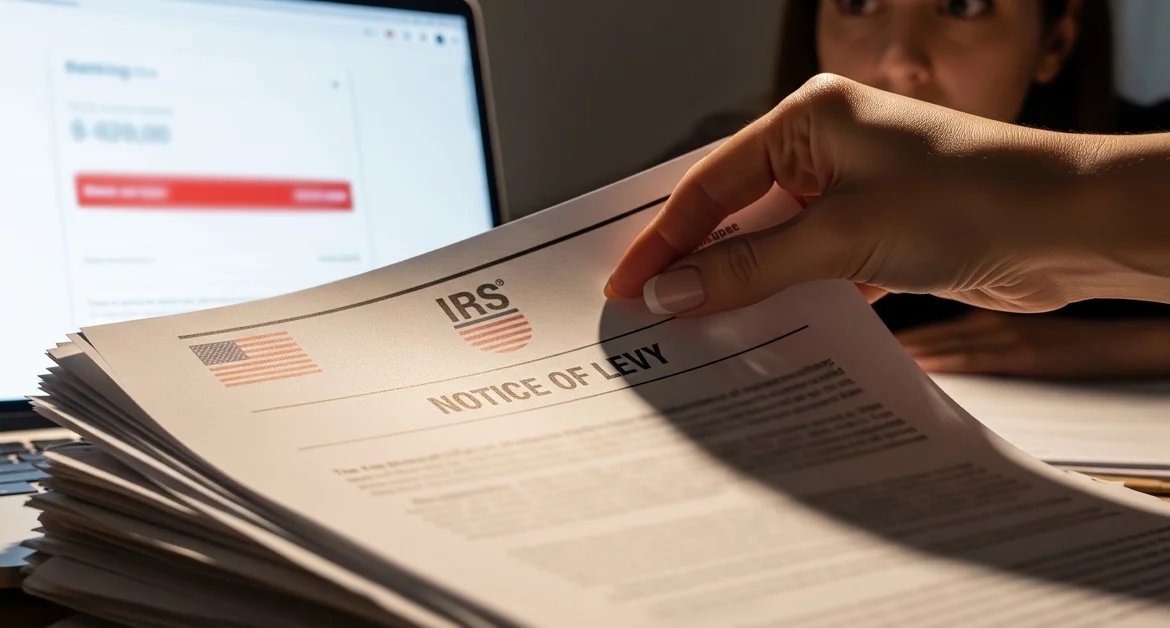Few IRS actions create more panic than a bank levy. One day your account looks normal, the next it’s frozen.
The IRS can direct your bank to hold funds and send them to cover unpaid taxes. But you are not powerless.
With quick action, you may stop the levy, release frozen money, and protect your finances moving forward.
Why Levies Happen—and Why Speed Matters
An IRS levy is the legal seizure of your property to satisfy a tax debt.
With bank accounts, the IRS serves your bank a notice to freeze funds and remit them after a waiting period.
With wages, the IRS issues a continuous garnishment notice to your employer. Levies usually follow multiple notices and a Final Notice of Intent to Levy that gives you a right to appeal.
Once a bank levy hits, the clock starts: banks generally hold the funds for 21 days before sending them to the IRS. Use that window—every day counts.
Related reading for context:
- What the IRS can and can’t take: What Assets Can the IRS Seize for Unpaid Taxes?
- Liens vs. liens by states (how filings differ): State Tax Liens vs. IRS Tax Liens – What’s the Difference?
How an IRS Bank Levy Works
Before a levy begins, the IRS must:
- Assess your tax liability.
- Send you a bill demanding payment.
- Issue a Final Notice of Intent to Levy at least 30 days before seizing funds.
Once the levy is sent, your bank freezes the funds in your account. They are held for 21 days before being forwarded to the IRS.
That 21-day window is your chance to act.
Step-by-Step: How to Stop an IRS Bank Levy
Step 1: Confirm the Levy Type and the Timeline
Identify exactly what you’re dealing with:
- Bank levy (Form 668-A(C)DO): Your bank freezes the balance on the day the levy hits and holds it for 21 days. If you get the levy released in time, the bank can lift the hold.
- Wage levy (Form 668-W): This is continuous and withholds each paycheck until the IRS releases it or the debt is resolved.
- Other levies: Accounts receivable, merchant accounts, or third-party payers can also be levied.
Gather the notice(s) you received, verify the tax years involved, and note the release deadline (21 days from the bank levy date).
Step 2: Call the IRS Immediately (Be Ready With Facts)
You’ll need:
- Your notice (or at least the tax years and balances).
- Current financials (income, necessary living expenses, bank balance).
- Proposed resolution (see Step 4).
If you have a representative, a signed Form 2848 (Power of Attorney) lets them call on your behalf.
Helpful call script opener:
“I received a bank levy on [date] for tax year(s) [years].
I’m calling to resolve the balance and request a levy release. I can [pay in full / enter a direct-debit installment agreement / demonstrate hardship].
What information do you need from me today to process the release?”
Step 3: Use the 21-Day Bank Levy Hold Strategically
That hold period is your chance to secure a levy release. The IRS will generally consider releasing a bank levy if:
- You pay in full (including penalties and interest), or
- You enter into a qualifying Installment Agreement (often direct-debit), or
- You qualify for Currently Not Collectible (CNC) due to hardship, or
- You submit a timely appeal (see Step 6), or
- There’s a procedural error (wrong taxpayer, wrong amount, already paid, bankruptcy stay, etc.).
Step 4: Choose the Fastest Resolution Path You Qualify For
Pick the option you can execute today—speed matters:
- Pay in Full
If you can liquidate safely or borrow at reasonable cost, full payment triggers a quick levy release once the payment posts. Ask the agent to fax or electronically transmit Form 668-D (Release of Levy) to your bank. - Direct-Debit Installment Agreement (DDIA)
For many taxpayers, this is the fastest practical solution. If you owe above certain thresholds, the IRS often requires direct debit. You can formalize a DDIA with Form 433-D and, when appropriate, Form 9465. Request a levy release contingent on the new agreement. (We also have a supportive guide: IRS Form 433-D: How to Set Up a Direct Debit Installment Agreement.) - Currently Not Collectible (CNC) Hardship
If paying would prevent you from meeting basic living expenses, ask for CNC. You’ll typically provide a quick financial statement (individuals: Form 433-F/433-A; businesses: Form 433-B) and supporting documents. If the IRS places your account in CNC, you can request a levy release based on undue hardship. - Offer in Compromise (OIC)
If you likely qualify to settle for less, you can submit an OIC. This isn’t instant, but the IRS may release a levy if you show serious hardship and a viable path (and you remain compliant). Many taxpayers pair an interim DDIA or CNC with an OIC filing. - Procedural or Legal Issues
Levies issued in error (e.g., wrong taxpayer, debt already paid, active bankruptcy, or pending timely appeal) should be released. Explain the defect and furnish proof.
Step 5: Give the IRS What It Needs—Fast
Be ready to transmit documents the same day:
- Proof of funds (if paying in full).
- Banking details for DDIA (routing/account numbers for Form 433-D).
- Financials for CNC or payment plan (paystubs, rent/mortgage, utilities, transportation, health insurance, required child support).
- Compliance proof (unfiled returns filed or in process).
- Any hardship documentation (eviction notice, shutoff notice, medical bills).
Ask the agent to fax or e-fax the levy release to your bank once approved.
Get the agent’s ID, the case/ACS number, and the where/when they’re sending the release so you can confirm with your bank.
Step 6: File an Appeal if Needed (CDP or CAP)
If you disagree with the levy or need time:
- Collection Due Process (CDP) Hearing – Form 12153
If you act by the deadline on your Final Notice of Intent to Levy, a timely CDP request halts most collection while Appeals reviews the case. - Collection Appeals Program (CAP) – Form 9423
Faster, more flexible than CDP, but you generally can’t go to Tax Court. Useful for disputing the appropriateness of a levy or pushing for a quick release.
Tell the IRS you’re filing, submit the form, and request a hold on enforced collection while Appeals reviews.
Step 7: Coordinate With Your Bank
Once the IRS authorizes a release, follow through:
- Confirm the bank has received the Form 668-D Release of Levy or an official IRS release letter.
- Ask when the freeze will lift.
- If funds were already sent, ask about any return options (often not possible once remitted).
- Document every call (names, dates, times).
Step 8: Prevent the Next Levy
A released levy is not a permanent pass. To avoid repeat action:
- Stay compliant: File all required returns, make current-year withholding/estimates.
- Automate your plan: If you’re in an installment agreement, use direct debit to avoid missed payments.
- Update promptly: If finances worsen, call the IRS before you miss a payment to discuss adjustments or hardship.
- Monitor notices: Respond before deadlines—especially to any new Final Notice.
When the IRS Must Release a Levy
Federal law requires the IRS to release a levy if:
- You pay the tax debt in full.
- The levy creates economic hardship.
- The IRS made a mistake or issued the levy improperly.
- The collection period has ended.
- You enter into a payment or settlement agreement.
Knowing these conditions gives you leverage when negotiating with the IRS.
What If the Levy Is on Wages (Not the Bank)?
A wage levy is continuous. To stop it:
- Get into a DDIA or secure CNC status, then request a wage levy release.
- If you qualify for an OIC or are filing a timely CDP/CAP appeal, ask for a release while that’s pending.
- Provide financials fast—wage levy releases commonly require updated income/expense info.
Documentation Checklist
- Notices (tax years, balances, deadlines)
- ID and contact info; POA (Form 2848) if represented
- Bank details for DDIA (Form 433-D)
- Financial statement (Form 433-F/433-A for individuals; 433-B for businesses)
- Proof of essential expenses (rent/mortgage, utilities, auto costs, insurance, childcare, required support)
- Compliance proof (filed or filing unfiled returns)
- Any hardship evidence (eviction/shutoff/medical)
Practical Examples (When Each Path Makes Sense)
- Short-term cash crunch: If you can pay in a week or two, call, pay in full, and request an immediate bank levy release so your funds are freed before day 21.
- Steady income, can afford payments: Request a DDIA during the call; once it’s approved, ask the agent to send the release to your bank.
- Hardship: If paying would stop you from meeting basic needs, request CNC with a quick 433-F. If approved, ask for the levy release based on hardship.
- Dispute or timing issue: If the levy notice is procedurally faulty or you’re within the CDP window, file Form 12153 and request an immediate hold/release while Appeals reviews.
Key Takeaways
- A bank levy triggers a 21-day hold—use that time to get a release.
- The fastest solutions are pay in full or a Direct-Debit Installment Agreement.
- Hardship (CNC) can stop collection when you can’t cover basic living costs.
- Appeals (CDP/CAP) can pause or reverse a levy if requested on time.
- Keep your account compliant to avoid the next levy.
Final Thoughts
An IRS bank levy can feel like the rug has been pulled out from under you. But the 21-day holding period gives you a chance to fight back.
By contacting the IRS, proving hardship, or entering into a payment plan, you can stop the levy and protect your money.
The sooner you act, the more options you have.


